#turing pattern
Explore tagged Tumblr posts
Text

Barks Quick "Turing patterns in CSP" tutorial
you need some pixels to start with, either just grab the spray bottle tool or go to Filter>Render>Perlin Noise
Filter> Gausian Blur> value: 6
Filter> Sharpen> unsharp mask> Radius: 22, Strenght: 255, Threshold: 0
----
you need to repeat step 2+3 over and over. to make that easier you can go to:
Auto Action> create new auto action set
hit record in the bottom left of the auto action window
perform step 2+3
stop recording
right click the actions in the set and duplicate them
make sure they are sorted correctly and hit play a few times
-----
before you color your pattern or do anything with it go to
Edit> tonal correction> binarization
to get rid of any odd colored pixels
#this isn´t the cleanest tutorial and i just figured it out too but i couldn´t find any tutorials for csp so throwing this one out here#clip studio paint#turing pattern#or as the sailfin lizard paper would call it Vermiculation#get vermiculating my friends
1K notes
·
View notes
Text
how to make cool blobby turing patterns in photoshop
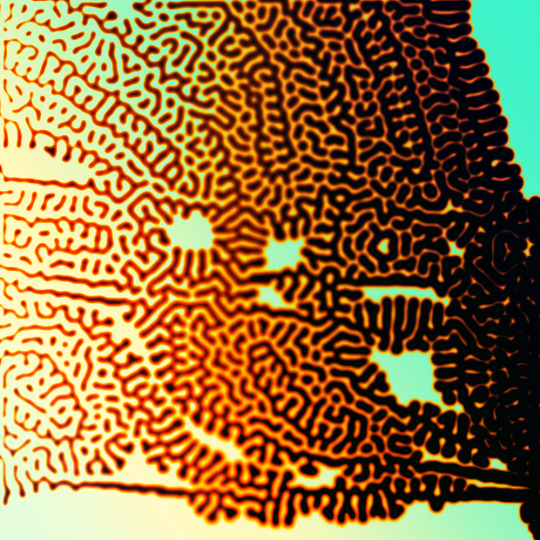
i'll preface with i learned the basic loop from skimming a tutorial on youtube, but as someone who prefers written tutorials i'm sure many would appreciate one! also, the second part of this is some of the visual effects i figured out on my own using blending modes and stuff.
i'm using photoshop CS4 on a mac so some buttons and stuff might be in different places on windows and newer photoshop versions but all the actions are the same. my canvas is 1000x1000 pixels.
UPDATES (i'm hoping these'll show up whenever you open the readmore?)
it's possible to do something similar in krita using this plugin, made by the love @arcaedex
it's also possible to do this in photopea, a free browser alternative to photoshop! the results are pretty much identical.
FIRST off you wanna get or make a black and white image of some kind. it has to be one layer. can be noise, a photo, a bunch of lines, whatever. here's mine, just some quick airbrush lines:

now find the actions tab. idk what it looks like in newer versions of photoshop but you probably won't need to dig!
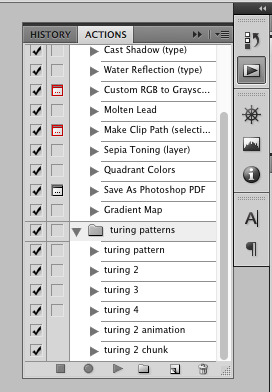
hit the little page thingy to make a new pattern. once you hit 'record', it'll record everything you do. the little square 'stop' icon will end it.
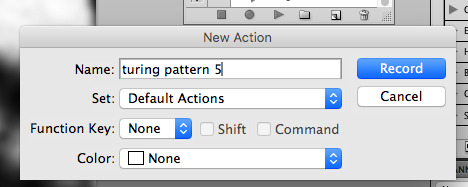
now you want to do a high pass filter. you can mess around with the radius to change the size of your squiggles, but the tutorial had it set to 6. experiment!
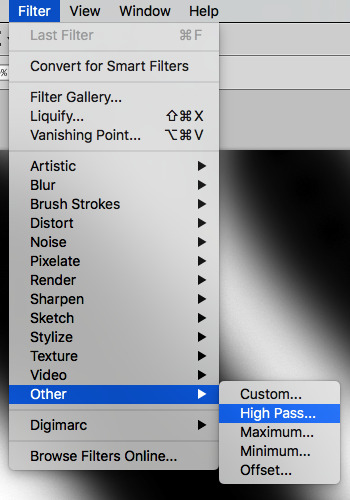

now add the 'threshold' adjustment layer. i use the adjustments tab but i think there's also a dropdown menu somewhere. keep it at the default, 128. merge it down. (control or command + E or you can right click it like some kind of weirdo)
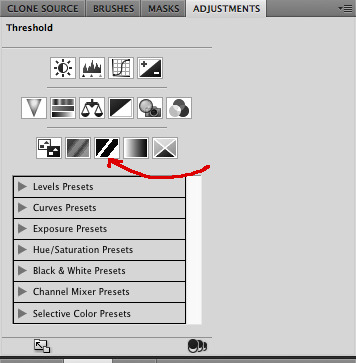
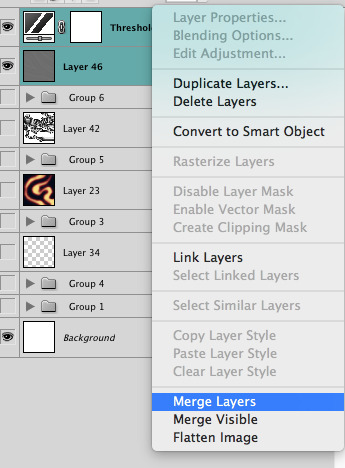
and finally, the gaussian blur! the radius of this affects the shape and size of your squiggles as well. i like to keep it around 4.5 but you can mess around with that too.
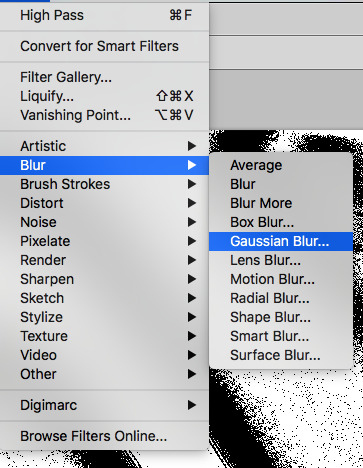

after that, hit 'stop' on the action you're recording, and then repeat it a bunch of times using the 'play' button, until you have something you like, like this:
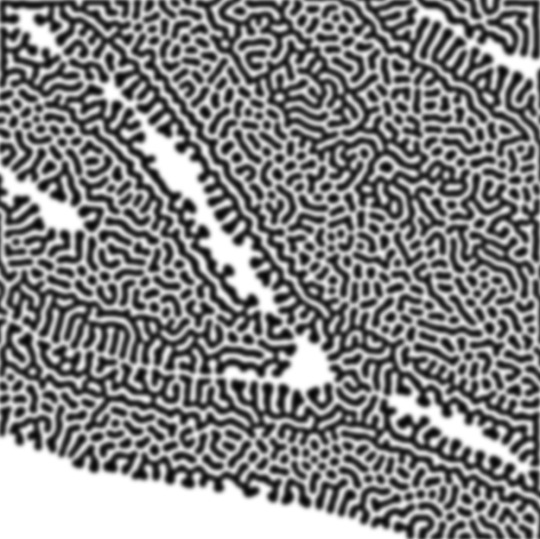
WOW!! that was fun!! and only a little tedious thanks to the power of macros. anyway, here's some fun layer blending stuff i like to do. it's with a different pattern cause i made this bit first.
anyway, using a black and white gradient (or a grey base that you do black and white airbrush on), make a layer with the vivid light. this will make the blobs look thicker or thinner.
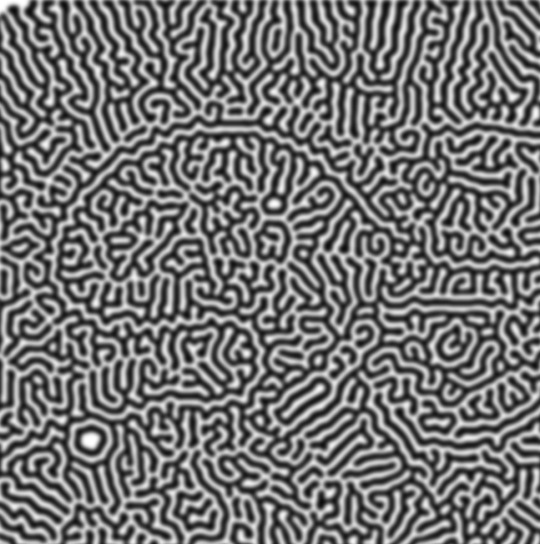

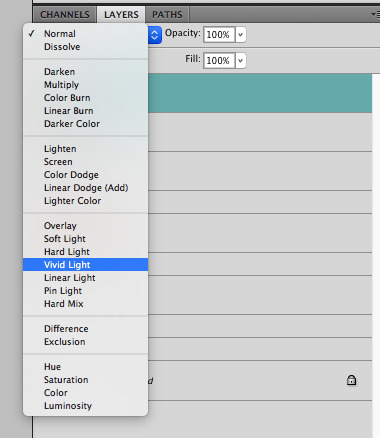

then, for cool colors, do a gradient map adjustment layer over that:

and finally, my best friend, the overlay layer. just using a gradient here bc i'm lazy, but feel free to experiment with brushes, colors, and blending modes!
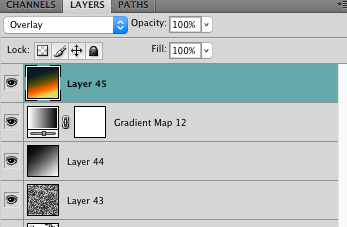

NOW GO. MAKE COOL SHIT WITH THE POWER OF MATH. AND SEND IT TO ME
also these are not hard and fast rules PLEASE mess around with them to see what kind of weird shit you can make. here's a gif. as you can see i added some random airblush blobs in the middle of it, for fun.
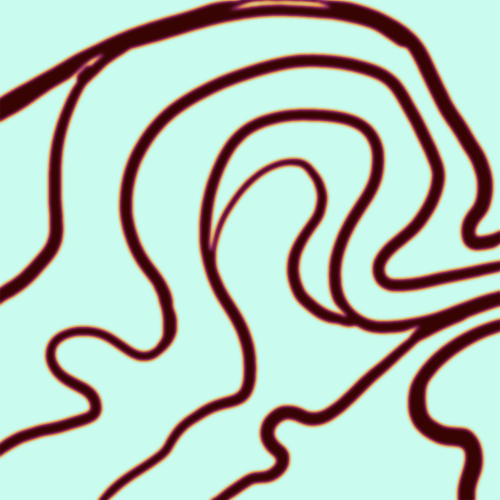
933 notes
·
View notes
Text
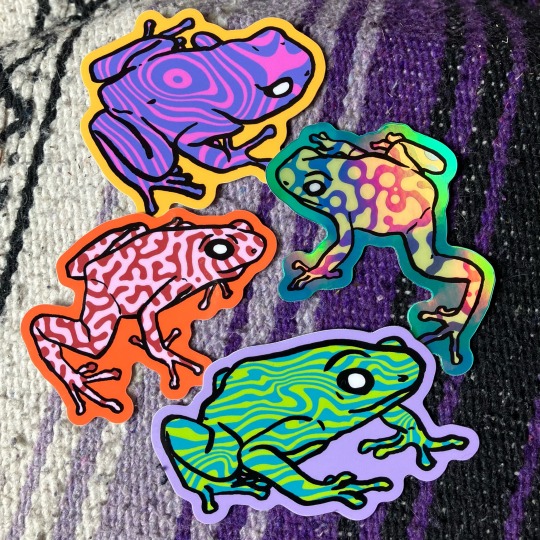
Let’s talk about Turing patterns!
Turing patterns are a concept introduced by mathematician Alan Turing, and he describes how patterns - shown here as stripes and splotches or spots on my frog stickers - occur naturally during morphogenesis (the process that causes tissue to form shape by controlling the spatial distribution of cells during early development).
In an otherwise stable and asymmetrical state of growth, the interaction of the chemicals controlling that growth autonomously result in the formation of pigmented markings on animals and plants.
And once you start to look, you’ll find Turing-style reaction-diffusion systems can be seen in all sorts of places:
Wind ripples in sand caused by the interplay of accumulation and degradation.
The nanoscale formation of atomically thin layers of bismuth crystals.
The uneven distribution of matter in galactic discs.
The feedbacks involved in replication, competition and predation may even set up organized patterns in animal communities.
Turing patterns are everywhere.
#Turing#Turing pattern#science#frogs#sticker art#stickers#morphogenesis#morphogenetic#nature#animals
8 notes
·
View notes
Text
If you want some fish accurate™️lore, I use reaction diffusion patterns. I think you can make them in most art programs.



Greatest enemy: The seal
63 notes
·
View notes
Text
"Turing's Cake (and other wrinkly math)"
youtube
0 notes
Text
Trickle down economics - the trick tycoons just can’t pull off.
The “bringing the jobs” stuff is insulting people into early graves, but the power consumption inequality may be what finishes off a lot of humans.
The CHIPS Act may result in products we actually need, if you want to continue to use computers, of course. And that’s the only reason to do “economic development” - to actually produce something humans need, or provide services humans need. There’s really no other reason for any business to exist, other than to actually provide things that humans need and want.
The people in power are going to endlessly try to trick us nevertheless about what the purpose of business is, and what we should think it is. But when they think nobody’s listening, they do say what’s up. I took the time to listen to this controversial talk given by billionaire tech tycoon Eric Schmidt. And just in case it wasn’t terribly obvious by now that “we’re giving you jobs” trickle down economics is not only pseudoscience, and not just insulting to our actual experience, but an actual trick – Well, here’s a tech tycoon basically spelling it out in a talk he didn’t realize was being recorded, describing how the CHIPS ACT was something AI tech tycoons essentially lobbied for, and that’s why this economic package passed.
Eric Schmidt Full Controversial Interview on AI Revolution (Former Google CEO) Financial Wise Aug 18, 2024 Eric Schmidt: “I talked Sam Alman is a close friend he believes that it's going to take about 300 billion maybe more I pointed out to him that I done the calculation on the amount of energy Acquired and I and I then in the spirit of full disclosure went to the White House on Friday and told them that we need to become best friends with Canada because Canada has really nice people helped invent AI and lots of Hydra power because we as a country do not have enough power to do this the alternative is to have the Arabs fund it and I like the Arabs personally uh spent lots of time there right but they're not going to adhere to our national security rules whereas Canada and the US are part of a triumvirate it where we all agree.” Erik Brynjolfsson: “so these $300 billion data centers, electricity starts becoming the scarce resource.” (...) Eric Schmidt: “I was the chairman of an AI commission that sort of looked at this very carefully and um you can read it it's about 752 pages and I'll just summarize it by saying we're ahead we need to stay ahead and we need lots of money to do so our customers were the Senate and the House um and out of that came the chips act and a lot of other stuff like that.”
If only politicians were so responsive to people, we might have the luxuries of Europeans, like universal healthcare and sectoral union bargaining.
Meanwhile we have a power plant in Pennsylvania that provides no electricity to the community at all, it only exists to print cryptocurrency for a tycoon, and they want to burn tires to keep printing that crypto.
Energy production pollution for no purpose other than cryptocurrency. Power plant is burning coal waste, burning construction debris, and planning to burn rubber. Chloe Humbert Nov 08, 2024
And whenever I have written to Bob Casey about AI seeming like a lot of scam garbage and the horrendous power issues involved with this industry, I’d repeatedly get this canned form response that referenced Turing Tests, and assuring me that tech tycoons had promised to make sure the products were safe without regulation.
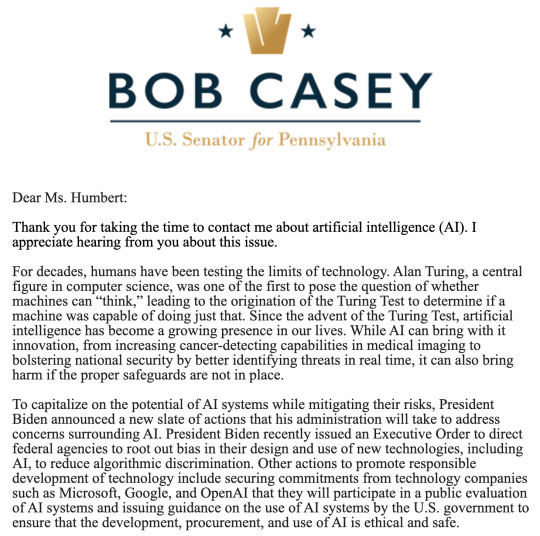
Bob Casey U.S. Senator for Pennsylvania. Dear Ms. Humbert: Thank you for taking the time to contact me about artificial intelligence (AI). I appreciate hearing from you about this issue. For decades, humans have been testing the limits of technology. Alan Turing, a central figure in computer science, was one of the first to pose the question of whether machines can “think,” leading to the origination of the Turing Test to determine if a machine was capable of doing just that. Since the advent of the Turing Test, artificial intelligence has become a growing presence in our lives. While AI can bring with it innovation, from increasing cancer-detecting capabilities in medical imaging to bolstering national security by better identifying threats in real time, it can also bring harm if the proper safeguards are not in place. To capitalize on the potential of AI systems while mitigating their risks, President Biden announced a new slate of actions that his administration will take to address concerns surrounding AI. President Biden recently issued an Executive Order to direct federal agencies to root out bias in their design and use of new technologies, including AI, to reduce algorithmic discrimination. Other actions to promote responsible development of technology include securing commitments from technology companies such as Microsoft, Google, and OpenAI that they will participate in a public evaluation of AI systems and issuing guidance on the use of AI systems by the U.S. government to ensure that the development, procurement, and use of AI is ethical and safe.
Meanwhile people are eating poison mushrooms out of AI generated books sold on Amazon along side fake children’s books that make no sense, and people selling fake nonsense crochet patterns, and… some regulation progress has been made on fake testimonials.
Like so many tycoons and moguls, Eric Schmidt also has nonsense investor driven attitudes about allowing the rabble – such as software engineers and mathematicians – to work from home.
Eric Schmidt’s car crash Stanford interview showed big tech’s true colors on remote work - Big tech bigwigs just can’t come to terms with remote work – RTO mandates and battles with staff could be their undoing - By Ross Kelly - published August 23, 2024 While Schmidt has since backtracked on his comments, they nonetheless point toward an antiquated view of remote working culture that seems pervasive among both the old guard of Silicon Valley and a host of major organizations. The horse has well and truly bolted on strict in-office attendance – the pandemic saw to that – yet so many big tech firms are slugging it out in a war of attrition with staff to claw them back on-site. Google, Schmidt’s former stomping ground, is arguably among the best examples of a company trying by any means to get staff back into the very expensive real estate it needs to justify filling.
We all know by now that telework is demonized because fossil fuel companies want everyone commuting, and the owners of commercial real estate want companies renting expensive office space. It’s not uncommon where the owners of companies will be both the business operator and the landlord.
The investments of the 50 most wealthiest people on the planet must be really something.
#trickle down economics#the economy#tycoons#chips act#eric schmidt#AI hype#scams#electricity#tech won’t save us#cryptocurrency#burning tires#bob casey#turing test#letters to reps#microsoft#google#poison mushrooms#AI slop#moguls#fake crochet patterns#the internet of fakes#RTO#remote work#telework#fossil fuel industry#commercial real estate#WFH#it’s just business
0 notes
Text
The reason i know AI is a passing fad and not a genuine threat is because its being pushed by the same goobers who were pushing things like crypto and the metaverse and nfts.
Its not a waste of energy to get mad about it. Make sure the companies adopting its worse iterations know they're fucking up. Thats part of how NFTs lost their luster. Just remember how often techbros bandwagon on the newest, dumbest, shiniest thing and dont panic.
#i have a whole thing about calling all these disparate programs AI because none of it is AI but im going for readability here#okay okay AI is an as of yet fictional program with sentience. the turing test is a hypothetical benchmark for AI to clear but#its not indicative that ai has actually been achieved#true AI might not even be technologically possible but OpenAI and Dall-E are baby steps toward it.#so far its just pattern recognition technologies#or in the case of the google search engine ai its literally just grabbing semirandom phrases from search results#idk the false marketing genuinely bothers me more than the programs themselves but the programs are problems lmao
1 note
·
View note
Text
edit: 4k texture upgrade >:)
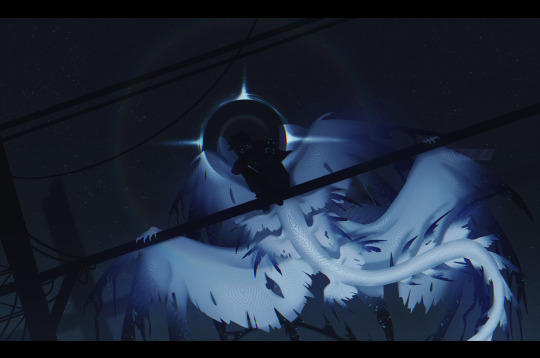
watching you :)
#i figured out how to draw the plant markings without drawing them by hand#those are turing patterns btw#theyre close enough#studio orange seems to take inspo from those#and sound resonance patterns#esp for the eye markings#theres a moment in the opening where those patterns appear too#and move with the frequency of whatever is playing#super cool detail
1K notes
·
View notes
Text
yo fuck this dude (this dude is scarus frenatus)
#mhac.txt#parrotfish teeth were freaking me out yesterday#and now i’ve just found the bridled parrotfish has a turing pattern to it#they’re targeting me
0 notes
Text
The syntax is like that of Lisp or Scheme, consisting of parenthesized lists. Keywords are in Arabic (specifically, Lebanese Arabic)[2] and program text is laid out right-to-left, like all Arabic text. The language provides a minimal set of primitives for defining functions, conditionals, looping, list manipulation, and basic arithmetic expressions. It is Turing-complete, and the Fibonacci sequence and Conway's Game of Life have been implemented. Because program text is written in Arabic and the connecting strokes between characters in the Arabic script can be extended to any length, it is possible to align the source code in artistic patterns, in the tradition of Arabic calligraphy.
shit that's cool. it should throw a syntax error if your calligraphy isn't sufficiently ornate.
583 notes
·
View notes
Text
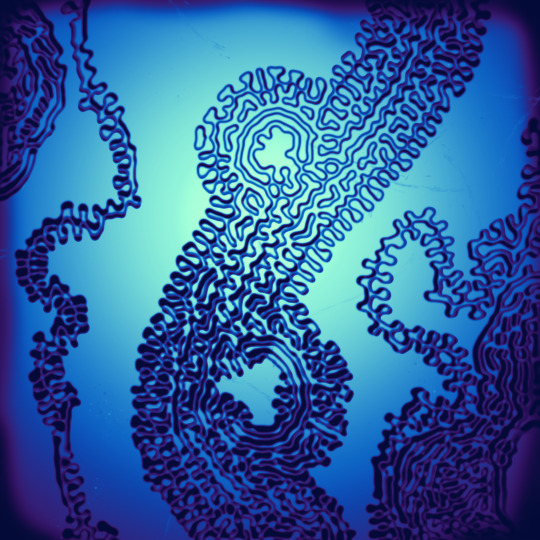
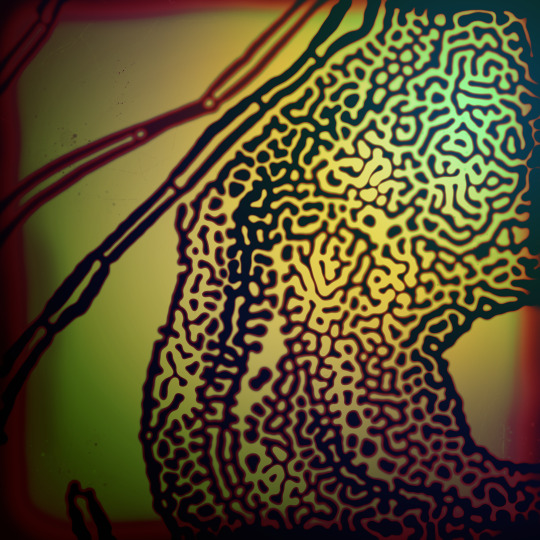

back at it again with the turing patterns
92 notes
·
View notes
Text
Are the means of computation even seizable?
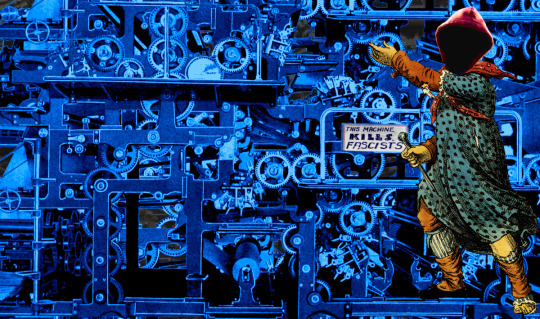
I'm on a 20+ city book tour for my new novel PICKS AND SHOVELS. Catch me in PITTSBURGH in TOMORROW (May 15) at WHITE WHALE BOOKS, and in PDX on Jun 20 at BARNES AND NOBLE with BUNNIE HUANG. More tour dates (London, Manchester) here.

Something's very different in tech. Once upon a time, every bad choice by tech companies – taking away features, locking out mods or plugins, nerfing the API – was countered, nearly instantaneously, by someone writing a program that overrode that choice.
Bad clients would be muscled aside by third-party clients. Locked bootloaders would be hacked and replaced. Code that confirmed you were using OEM parts, consumables or adapters would be found and nuked from orbit. Weak APIs would be replaced with muscular, unofficial APIs built out of unstoppable scrapers running on headless machines in some data-center. Every time some tech company erected a 10-foot enshittifying fence, someone would show up with an 11-foot disenshittifying ladder.
Those 11-foot ladders represented the power of interoperability, the inescapable bounty of the Turing-complete, universal von Neumann machine, which, by definition, is capable of running every valid program. Specifically, they represented the power of adversarial interoperability – when someone modifies a technology against its manufacturer's wishes. Adversarial interoperability is the origin story of today's tech giants, from Microsoft to Apple to Google:
https://www.eff.org/deeplinks/2019/10/adversarial-interoperability
But adversarial interop has been in steady decline for the past quarter-century. These big companies moved fast and broke things, but no one is returning the favor. If you ask the companies what changed, they'll just smirk and say that they're better at security than the incumbents they disrupted. The reason no one's hacked up a third-party iOS App Store is that Apple's security team is just so fucking 1337 that no one can break their shit.
I think this is nonsense. I think that what's really going on is that we've made it possible for companies to design their technologies in such a way that any attempt at adversarial interop is illegal.
"Anticircumvention" laws like Section 1201 of the 1998 Digital Millennium Copyright Act make bypassing any kind of digital lock (AKA "Digital Rights Management" or "DRM") very illegal. Under DMCA, just talking about how to remove a digital lock can land you in prison for 5 years. I tell the story of this law's passage in "Understood: Who Broke the Internet," my new podcast series for the CBC:
https://pluralistic.net/2025/05/08/who-broke-the-internet/#bruce-lehman
For a quarter century, tech companies have aggressively lobbied and litigated to expand the scope of anticircumvention laws. At the same time, companies have come up with a million ways to wrap their products in digital locks that are a crime to break.
Digital locks let Chamberlain, a garage-door opener monopolist block all third-party garage-door apps. Then, Chamberlain stuck ads in its app, so you have to watch an ad to open your garage-door:
https://pluralistic.net/2023/11/09/lead-me-not-into-temptation/#chamberlain
Digital locks let John Deere block third-party repair of its tractors:
https://pluralistic.net/2022/05/08/about-those-kill-switched-ukrainian-tractors/
And they let Apple block third-party repair of iPhones:
https://pluralistic.net/2022/05/22/apples-cement-overshoes/
These companies built 11-foot ladders to get over their competitors' 10-foot walls, and then they kicked the ladder away. Once they were secure atop their walls, they committed enshittifying sins their fallen adversaries could only dream of.
I've been campaigning to abolish anticircumvention laws for the past quarter-century, and I've noticed a curious pattern. Whenever these companies stand to lose their legal protections, they freak out and spend vast fortunes to keep those protections intact. That's weird, because it strongly implies that their locks don't work. A lock that works works, whether or not it's illegal to break that lock. The reason Signal encryption works is that it's working encryption. The legal status of breaking Signal's encryption has nothing to do with whether it works. If Signal's encryption was full of technical flaws but it was illegal to point those flaws out, you'd be crazy to trust Signal.
Signal does get involved in legal fights, of course, but the fights it gets into are ones that require Signal to introduce defects in its encryption – not fights over whether it is legal to disclose flaws in Signal or exploit them:
https://pluralistic.net/2023/03/05/theyre-still-trying-to-ban-cryptography/
But tech companies that rely on digital locks manifestly act like their locks don't work and they know it. When the tech and content giants bullied the W3C into building DRM into 2 billion users' browsers, they categorically rejected any proposal to limit their ability to destroy the lives of people who broke that DRM, even if it was only to add accessibility or privacy to video:
https://www.eff.org/deeplinks/2017/09/open-letter-w3c-director-ceo-team-and-membership
The thing is, if the lock works, you don't need the legal right to destroy the lives of people who find its flaws, because it works.
Do digital locks work? Can they work? I think the answer to both questions is a resounding no. The design theory of a digital lock is that I can provide you with an encrypted file that your computer has the keys to. Your computer will access those keys to decrypt or sign a file, but only under the circumstances that I have specified. Like, you can install an app when it comes from my app store, but not when it comes from a third party. Or you can play back a video in one kind of browser window, but not in another one. For this to work, your computer has to hide a cryptographic key from you, inside a device you own and control. As I pointed out more than a decade ago, this is a fool's errand:
https://memex.craphound.com/2012/01/10/lockdown-the-coming-war-on-general-purpose-computing/
After all, you or I might not have the knowledge and resources to uncover the keys' hiding place, but someone does. Maybe that someone is a person looking to go into business selling your customers the disenshittifying plugin that unfucks the thing you deliberately broke. Maybe it's a hacker-tinkerer, pursuing an intellectual challenge. Maybe it's a bored grad student with a free weekend, an electron-tunneling microscope, and a seminar full of undergrads looking for a project.
The point is that hiding secrets in devices that belong to your adversaries is very bad security practice. No matter how good a bank safe is, the bank keeps it in its vault – not in the bank-robber's basement workshop.
For a hiding-secrets-in-your-adversaries'-device plan to work, the manufacturer has to make zero mistakes. The adversary – a competitor, a tinkerer, a grad student – only has to find one mistake and exploit it. This is a bedrock of security theory: attackers have an inescapable advantage.
So I think that DRM doesn't work. I think DRM is a legal construct, not a technical one. I think DRM is a kind of magic Saran Wrap that manufacturers can wrap around their products, and, in so doing, make it a literal jailable offense to use those products in otherwise legal ways that their shareholders don't like. As Jay Freeman put it, using DRM creates a new law called "Felony Contempt of Business Model." It's a law that has never been passed by any legislature, but is nevertheless enforceable.
In the 25 years I've been fighting anticircumvention laws, I've spoken to many government officials from all over the world about the opportunity that repealing their anticircumvention laws represents. After all, Apple makes $100b/year by gouging app makers for 30 cents on ever dollar. Allow your domestic tech sector to sell the tools to jailbreak iPhones and install third party app stores, and you can convert Apple's $100b/year to a $100m/year business for one of your own companies, and the other $999,900,000,000 will be returned to the world's iPhone owners as a consumer surplus.
But every time I pitched this, I got the same answer: "The US Trade Representative forced us to pass this law, and threatened us with tariffs if we didn't pass it." Happy Liberation Day, people – every country in the world is now liberated from the only reason to keep this stupid-ass law on their books:
https://pluralistic.net/2025/01/15/beauty-eh/#its-the-only-war-the-yankees-lost-except-for-vietnam-and-also-the-alamo-and-the-bay-of-ham
In light of the Trump tariffs, I've been making the global rounds again, making the case for an anticircumvention repeal:
https://www.ft.com/content/b882f3a7-f8c9-4247-9662-3494eb37c30b
One of the questions I've been getting repeatedly from policy wonks, activists and officials is, "Is it even possible to jailbreak modern devices?" They want to know if companies like Apple, Tesla, Google, Microsoft, and John Deere have created unbreakable digital locks. Obviously, this is an important question, because if these locks are impregnable, then getting rid of the law won't deliver the promised benefits.
It's true that there aren't as many jailbreaks as we used to see. When a big project like Nextcloud – which is staffed up with extremely accomplished and skilled engineers – gets screwed over by Google's app store, they issue a press-release, not a patch:
https://arstechnica.com/gadgets/2025/05/nextcloud-accuses-google-of-big-tech-gatekeeping-over-android-app-permissions/
Perhaps that's because the tech staff at Nextcloud are no match for Google, not even with the attacker's advantage on their side.
But I don't think so. Here's why: we do still get jailbreaks and mods, but these almost exclusively come from anonymous tinkerers and hobbyists:
https://consumerrights.wiki/Mazda_DMCA_takedown_of_Open_Source_Home_Assistant_App
Or from pissed off teenagers:
https://www.theverge.com/2022/9/29/23378541/the-og-app-instagram-clone-pulled-from-app-store
These hacks are incredibly ambitious! How ambitious? How about a class break for every version of iOS as well as an unpatchable hardware attack on 8 years' worth of Apple bootloaders?
https://pluralistic.net/2020/05/25/mafia-logic/#sosumi
Now, maybe it's the case at all the world's best hackers are posting free code under pseudonyms. Maybe all the code wizards working for venture backed tech companies that stand to make millions through clever reverse engineering are just not as mad skilled as teenagers who want an ad-free Insta and that's why they've never replicated the feat.
Or maybe it's because teenagers and anonymous hackers are just about the only people willing to risk a $500,000 fine and 5-year prison sentence. In other words, maybe the thing that protects DRM is law, not code. After all, when Polish security researchers revealed the existence of secret digital locks that the train manufacturer Newag used to rip off train operators for millions of euros, Newag dragged them into court:
https://fsfe.org/news/2025/news-20250407-01.en.html
Tech companies are the most self-mythologizing industry on the planet, beating out even the pharma sector in boasting about their prowess and good corporate citizenship. They swear that they've made a functional digital lock…but they sure act like the only thing those locks do is let them sue people who reveal their workings.

If you'd like an essay-formatted version of this post to read or share, here's a link to it on pluralistic.net, my surveillance-free, ad-free, tracker-free blog:
https://pluralistic.net/2025/05/14/pregnable/#checkm8
#pluralistic#apple#drm#og app#instagram#meta#dmca 1201#comcom#competitive compatibility#interop#interoperability#adversarial interoperability#who broke the internet#self-mythologizing#infosec#schneiers law#red team advantage#attackers advantage#luddism#seize the means of computation
429 notes
·
View notes
Text
Android Tim Drake AU:
Drake Industries announced they had successfully created realistic-looking androids that passed the Turing Test (and harder versions of it). They were planning to release commercial models to the public within twenty years.
To go a step farther, the Drakes wanted to ensure no one was skeptical of the androids' abilities to pass as human. Thus, Janet and Jack Drake had a healthy "human" baby by the name of Timothy Jackson Drake. The only individuals aware of this are Tim, Janet, Jack, and a small handful of engineers bound with a fuck ton of NDAs. They planned to tell the public when Tim was eighteen.
While Janet and Jack Drake are aware of Tim's ability to mimic emotions, they do not believe him to be capable of actually feeling them. This leads to Tim's childhood being lonely and neglectful. He is a robot.
At first, Tim is incapable of consuming human foods or using his touch sense. They fix his touch sense by the time he is four (and thus Dick is his first hug), and the food by the time he is six. He is constantly undergoing repairs to allow him to mimic the growth pattern of a child. It's when he is nine that he finally gets pain sensors to discourage and alert him to damage.
Tim is, for all intents and purposes, legally a human. When Janet dies and Jack gets into a coma, Tim stops receiving "growth spurts." He remains the same size even after Jack wakes up from his coma.
When Tim becomes Robin, he does not disclose his status with Bruce, Dick, or anyone else. Given that his parents treat him like an object, a machine, and incapable of feelings, Tim doesn't want to be subjected to that by his heroes either.
Instead, he gaslights the hell out of the Bats, villains, and other heroes whenever he gets hit.
["Tim! You got flung into a building. You are getting a medical exam."
Tim narrows his eyes as his eyebrows raise in surprise. "Bruce.... what are you talking about?"
"I saw you get thrown into a building. You're not getting out of this."
Tim glances to the side and then back to his mentor. He carefully places a hand on Bruce's shoulder. "B... Maybe we should have Alfred check you over."
Bruce blinks in shock as his brows furrow. "What?"
Tim purses his lips and shakes his head in pity. "It's okay, B. We'll figure it out. Whatever is going on, we'll fix it."
Bruce is so confused and concerned he doesn't ask Tim to get a medical check and agrees to be checked over instead.]
Tim becomes an expert at repairing himself because he can't explain to the engineers (most of who were let go after Janet died) how he got damaged. He spends a lot of nights alone in his room turning off his pain sensors (which isn't an automatic process and is difficult to reach)in order to fix the mangled hand, the gaping gash, the crooked foot, etc.
Kon, and conversely YJ, are the first to find out about his status (darn x-ray vision and super hearing). This encourages Tim to create artificial sounds within himself to fool Superman when they first meet. This also forces Tim to wear a long-sleeved uniform and a hood to hide from x-ray vision.
Tim finds comradery with Red Tornado.
When Jack wakes up from his coma, he originally treats Tim as he did before: an object. Dana, though, changes this. Jack can't explain why he treats his "son" that way and slowly morphs into becoming a good father.
It starts as only occurring when Dana is in the room and ends with a very bitter and antagonistic Jack when she leaves. He is initially disturbed by how much Tim is "faking" emotions, particularly because Tim learned to conceal his emotions from his parents as a coping mechanism (not that Jack knows this).
As they start spending more and more time together, Jack begins accepting the idea that Tim is capable of emotions. He starts caring and loving the kid as his own.
Because of this, Jack becomes fearful for Tim. When he learns that Tim is Robin, he is both jealous of Bruce's relationship with Tim and absolutely terrified for his son (what happens if people find out that Tim is an android? How would they treat him? Tim told Jack the Waynes don't know about his status. What if Tim gets injured too badly during a mission and they find out?)
This is why Jack initially forbids Tim from being Robin. There is way too much at stake for Tim if he continues (even though, theoretically, Tim can't die. Jack can keep saves of Tim and import him into a new body if necessary. They both don't want to do this, however, because Tim's body is his. It would feel weird and wrong to put him in another one).
While Tim is prohibited from being Robin, Jack bankrupts his company in the process of getting Tim rights. He bribes the hell out of judges, law makers, etc. to subtly put I'm rights for androids. He wants Tim to have full access to his inheritance, to freedom, and to everything humans can do. He doesn't want Tim to be without it.
Tim doesn't understand why Drake Industries is going under and is pissed at Jack for preventing him from being Robin. Robin is everything to Tim. It allows him to be treated as human. It connects him to so many people.
It's only afterwards, when Tim is finally allowed to be Robin again (and Jack has ensured he did everything he could for now for Tim's rights), that Tim fully understands how much Jack loves and cares for him.
Then Jack dies.
Tim is able to hide the fact that he's an android up until a Red Helmet asshole breaks into the Tower. While YJ whisk him away before the Bats can find out, Jason knows. Jason found out.
#tim drake#dc au#android au#good parent jack drake#eventually#jack drake loves tim#jack drake#i like to imagine janet learns to love her kid too but only after she dies#when jack meets her in the after life she's so proud of jack for being there for their son#i love jason todd y'all#this isn't hate on jason
882 notes
·
View notes
Text
Ulrich: The Awakened Ferroliquid is actually based on the research and findings of Alan Turing, the man know for the early concept of the internet and computer.
This will be an analysis of how Ulrich is inspired by Alan Turing, and theorise exactly what Ulrich is planning to do in 2.8 (so this is a discussion on CN patch 2.8 not global friendly)


Alr: the immediate though that came to Ulrich since his appearance in 1.9 was that he was an Awakened from the invention of the ferroliquid, until now this was largely accepted/ considered since we did not know much outside of his job as the Lead Cryptographer.
That was until 2.8 and the reveal as the free 6* in the new gamemode!
Why isn't he based exactly on the invention of the Ferroliquid? That's because the ferroliquid was formerly invented and discovered in its state in 1963 by Steve Papell of Nasa, and yet Ulrich's Era is stated to be 2 decades before.
So why Alan Turing?
Looking at Ulrich's birthday 30th May around the 1940s one of the significant events related to Cryptography was during WW2 Alan Turing alongside Gordon Welchman designated the British Bombes to help decrypt the Wehrmacht Engima machine signals (and yes Engima is based on this cipher machine). Ulrich's character story in 2.4 with him deciphering oscioscope with Engima by the end of the character story could be a reference to this.
One of Turing's inventions was the Turing Pattern, a concept that described which describes how patterns in nature, such as stripes and spots, can arise naturally and autonomously from a homogeneous, uniform state. This can be seen in 1.9 when Ulrich told Ms Radio to "groove to the incantation" in order to transmit the Storm Immunity Incantation to team TK on Aperion without the consquences of the incantation affecting the transmitter and the reciever.

These patterns can be seen in Ulrich's signature and in his ult:

The best way to test Turing's pattern is using ferrofluid, hence why Ulrich is an Awakened Ferrofluid.
Ulrich's role in 2.8

What is Ulrich planning to do in Antractica, and how does it relate to Alan Turing's work?
2.4 and to some extent 2.7 have been alluding to Ulrich's experiments involving Storm Immunity, as in 2.4 he attempts to test if the properties of the Regulus Disk that enabled the Satellite to resist the Storm before it crashed into Regulus' era if it can be replicated by making copies of the disk, down to the same ink and manufacturing of the disk. However the original disk remained perfectly unharmed and the multiple copies were destroyed in the process.
With little information most of us were asking why was Ulrich testing Storm Immunity again even though since 1.9 the Foundation had the Umbrellas? The CN website teasing aspects of 2.8 (credit to Merui for the translations) have revealed exactly what Ulrich hopes to do:

This reveals exactly how the Satellite: (1) remained in orbit following the First Storm since we get told in Ulrich's story the satellite had been put up prior to the First Storm, and (2) made the satellite 'resistant' to the Storm since 2.8 revealed that even space to a degree was affected by the Storm. Its crash likely the result of lack of maintenance and that it wasn't 'immune' but 'resistant', crashing into the 1960s era of Regulus.
(Also this explains why just his head made it out, the disk gave him enough time to ensure his survival via saving is Awakened form)
So therefore: Ulrich plans to replicate the disk's properities over a wider range of area outside just a ship, so I spectulate this is his role in 2.8.
The poster teaser alludes to a big battle between Foundation and Manus forces, and we know since 2.2 Sophia intends to create a Storm rather than accelerate a pre-existing one. From the PV its clear the Foundation loses and Arcana is revived, a Storm is very likely to happen however it is unknown this will happen after or during Arcana's revival.
So Ulrich's role is a trail by fire, test if the disk or its properties can affect a large enough area when the Storm hits to buy Foundation/ others time to evacute from the incoming Storm.
I think we can look at Alan Turing again for what Ulrich is planning to test:

In other words, keeping a certain radius in its intial state prior to the Storm hitting it = putting a pause on the Storm in an area for a brief moment.
Summary: Ulrich is an Awakened based on the Turing Pattern, which is best shown through Ferrofluids. Ulrich's role in 2.8 is likely to create a method to briefly pause the Storm's effect in a radius and ensure more people survive the evacuation of the Storm, that in the inevitable event that Arcana is revived and/ or the Manus is finally able to create their own Storms the Foundation have at least two countermeasures in the from of a Storm delayer and the Equilibrium Umbrella to combat it.
#reverse 1999#r1999#forgor remembered#ramblings#cn spoilers#ulrich#ulrich reverse 1999#2.8 spoilers#2.8 discussion
94 notes
·
View notes
Text
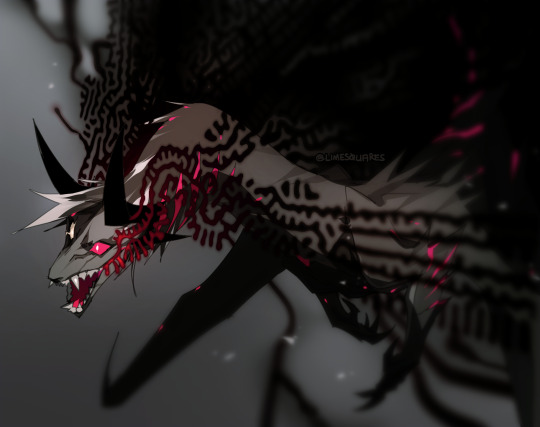
Unraveling
saw @/tickfleato's post about generating turing patterns and was compelled to do the same thing for hours! the Mika is incidental.
#lime art#oc: mikhael antares#simply goofing about#go check out the post though#it's easy and fun and FREE#fyi! if you dont have PS please google Photopea :)#Sacred Blood
740 notes
·
View notes
Text
Alien art on a Living canvas

A Scene taking place just shy of 10 billion years before man evolved. A Factorem paints a portrait of their species tenderly holding the Apprentice species. A sophont that they created from scratch from the hybrid dna of a dozen different animals from one of the few multicellular biospheres of their home galaxy.
In the wake of the Mandate of Creation, unifying their entire species and transforming their society. Making the Factorem a species that uses biotechnology in day to day life purely out of choice. One of their biggest forms of art would be given several exonyms by human eavesdroppers. Morphogenic-bending or simply Turing-art. Molding and manipulating the turing patterns and natural coloration of living canvases into art.
Once you get past this insane and probably morbid art medium they were alot like us. They used these living canvases to make portraits of people belonging to species not of their own, landscapes of alien worlds, and spacescapes of distant galactic filaments. All either by their people's literal creation. species they uplifted, worlds they terraformed, galactic filaments they possibly arranged themselves. Or it was merely birthed from the imagination of an everyday artist.
Turing patterns just by default were also a very common motif within Factorem cultural patterns, art they used to honor their communities, even the signia they used to represent their entire civilization was formed from a Turing pattern
~~~~~~~~~~~~~~~~~~~~~~~~~~~~~~~~~~~~~~~
This was just meant to be a discord doodle only about the painting itself. I blacked out and woke up to this and ended up with a new lighting technique that I think i will never ever drop now.
#my art#artist on tumblr#art#speculative biology#alien species#worldbuilding#sophont#a story of our universe
64 notes
·
View notes